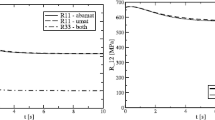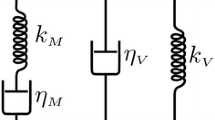Abstract
This article generalizes the results of a study of the structure of the constitutive equations of viscoelastic materials. The thermodynamics of irreversible processes is used to derive the constitutive equations. The concepts of generalized dissipative potential and rheologically simple behavior are used within this framework. Several new general models have already been constructed, and their relationship to well-known theories is established in the article.
Similar content being viewed by others
References
J. Batai, D. G. B. Edelen, and J. Kestin, “Structure of thermodynamic flows: direct application of a dissipative inequality,” in:Thermodynamics and Kinetics of Biological Processes [Russian translation], Nauka, Moscow (1980), pp. 187–197.
V. L. Berdichevskii,Variational Principles in Continuum Mechanics [in Russian], Nauka, Moscow (1983).
B. L. Bukhin,Introduction to the Mechanics of Pneumatic Tires [in Russian], Khimiya, Moscow (1988).
S. S. Volkov, Yu. N. Orlov, and B. Ya. Chernyak,Ultrasonic Welding of Plastics [in Russian], Khimiya, Moscow (1974).
S. Groot and P. Mazur,Nonequilibrium Thermodynamics [Russian translation], Mir, Moscow (1964).
I. Djarmati,Nonequilibrium Thermodynamics. Field Theory and Variational Principles [Russian translation], Mir, Moscow (1974).
A. A. Il'yushin,Plasticity. Principles of a Mathematical Theory [in Russian], Izd. AN SSSR, Moscow (1963).
A. A. Il'yushin and B. E. Pobedrya,Principles of a Mathematical Theory of Thermoviscoelasticity [in Russian], Nauka, Moscow (1970).
V. G. Karnaukhov, “Nonlinear theory of thermoviscoelasticity for a generalized thermorheologically simple material,”Prikl. Mekh.,14, No. 1, 16–29 (1978).
V. G. Karnaukhov, “Thermomechanical theory of viscoelasticity for a generalized thermorheologically simple material,”Prikl. Mekh.,14, No. 2, 24–35 (1978).
V. G. Karnaukhov, “Thermomechanical theory of viscoelasticity for a generalized thermorheologically simple material,” in:Symposium: Thermal Stresses in Structural Elements, Nauk. Dumka, Kiev (1978), Vol. 18, pp. 3–10.
V. G. Karnaukhov,Coupled Problems of Thermoviscoelasticity [in Russian], Nauk. Dumka, Kiev (1982).
V. G. Karnaukhov, “Phenomenological models of generalized thermorheologically simple inelastic ferroelectric materials,”Mat. Metodv i Fiz.-Mekh. Polya, No. 3, 3–13 (1998).
V. G. Karnaukhov, “Phenomenological models of inelastic ferromagnetic materials in the space of internal time,”Prikl. Mekh.,34, No. 10, 67–72 (1988) (Int. Appl. Mech.,34, No. 10, 981–986 (1998)).
V. G. Karnaukhov, “Thermodynamic theory of generalized thermorheologically simple viscoelastic ferromagnetic materials with a fading memory,”Prikl. Mekh.,35, No. 1, 45–49 (1999) (Int. Appl. Mech.,35, No. 1, 41–45 (1999)).
V. G. Karnaukhov and B. P. Gumenyuk,Thermomechanics of Predeformed Viscoelastic Bodies [in Russian], Nauk. Dumka, Kiev (1990).
V. G. Karnaukhov and I. K. Senchenkov, “Fundamental thermomechanical theory of viscoelasticity for generalized thermorheologically simple materials,”Prikl. Mekh.,15, No. 2, 41–48 (1979).
V. G. Karnaukhov and I. K. Senchenkov, “Thermodynamic theory of differential media with internal variables,”Prikl. Mekh.,15, No. 8, 19–27 (1979).
V. G. Karnaukhov and I. K. Senchenkov, “Certain simplified models in the fundamental thermomechanical theory of nonlinear viscoelasticity,”Vopr. Dinam. Prochn.,36, 127–137 (1980).
V. G. Karnaukhov and I. K. Senchenkov, “Modeling thermomechanical processes in the ultrasonic welding of plastics,” in: N. A. Shul'ga and V. T. Tomashevskii, eds.,Processing Stresses and Strains in Materials [in Russian], Vol. 6 of the 12-vol.Mechanics of Composites, A.S.K. Publ., Kiev (1997), pp. 81–115.
A. D. Kovalenko and V. G. Karnaukhov, “Equations and solution of certain problems of the theory of viscoelastic shells,”Symposium: Thermal Stresses in Structural Elements, Nauk. Dumka, Kiev (1967), Vol. 7, pp. 11–24.
A. D. Kovalenko and V. G. Karnaukhov, “Linearized theory of thermoviscoelasticity,”Mekh. Polim., No. 2, 214–221 (1972).
A. D. Kovalenko and V. G. Karnaukhov, “Heat generation in viscoelastic shells of revolution during periodic excitation,”Symposium: Thermal Stresses in Structural Elements, Nauk. Dumka, Kiev (1971), Vol. 11, pp. 5–11.
A. D. Kovalenko and V. G. Karnaukhov, “Main features of the behavior of viscoelastic orthotropic shells made of a generalized thermorheologically simple material,” Nauk. Dumka, Kiev (1972), Vol. 12, 5–18.
V. G. Karnaukhov and I. F. Kirichok,Mechanics of Coupled Fields in Structural Elements, Vol. 4, Thermoelectroviscoelasticity [in Russian], Nauk. Dumka, Kiev (1988).
B. E. Pobedrya, “Coupled problems of thermoviscoelasticity,”Mekh. Polim., No. 3, 415–421 (1969).
B. E. Pobedrya, “Coupled problems of continuum mechanics,”Symposium: Elasticity and Inelasticity [in Russian], Izd. MGU (1971), Vol. 2, pp. 224–253.
A. Ya. Gol'dman,Prediction of the Deformation-Strength Properties of Polymers and Composites [in Russian], Khimiya, Leningrad (1988).
P. Pezhina,Physical Theory of Viscoelasticity [Russian translation], Mir, Moscow (1974).
P. Pezhina and V. Voino, “Unified constitutive equations for a viscoelastoplastic material,”Mekhanika: Novoe v Zarubezhnoi Nauke, No. 7, 91–110 (1976).
Yu. N. Rabotnov,Creep in Structural elements [in Russian], Nauka, Moscow (1966).
L. I. Sedov,Continuum Mechanics [in Russian], Vol. 1, Nauka, Moscow (1969).
I. K. Senchenkov, “Toward a theory of simple media with thermomechanical constraints,”Transactions of the II All-Republic Conference of Young Scientists in Mechanics, Nauk. Dumka, Kiev (1979), pp. 204–207.
I. K. Senchenkov, “Constitutive equations of the theory of simple media with differential constraints,”Dopov. Akad. Nauk Ukr. RSR Ser. A, No. 7, 60–63 (1980).
I. K. Senchenkov and Ya. A. Zhuk, “Thermodynamic analysis of one model of the thermoviscoplastic deformation of materials,”Prikl. Mekh.,33, No. 2, 41–48 (1997) (Int. Appl. Mech.,33, No. 2, 122–128 (1997).
I. K. Senchenkov and V. G. Karnaukhov, “Toward a theory of media of the integro-differential type,”Dopov. Akad. Nauk Ukr. RSR Ser. A, No. 4, 288–293 (1979).
I. K. Senchenkov and V. G. Karnaukhov, “One variant of the fundamental thermomechanical theory of viscoelasticity for thermorheologically simple materials,”Prikl. Mekh.,17, No. 5, 38–44 (1981).
I. K. Senchenkov and V. G. Karnaukhov, “Certain general variational principles of thermomechanics,”Mekh. Elastomerov, 43–50 (1981).
I. K. Senchenkov, Ya. A. Zhuk, G. A. Tabieva, and O. P. Chervinko, “Simplified models of the coupled thermoviscoplastic behavior of bodies during harmonic loading,”Prikl. Mekh.,33, No. 9, 24–33 (1997) (Int. Appl. Mech.,33, No. 9, 698–705 (1997)).
I. K. Senchenkov, Ya. A. Zhuk and G. A. Tabieva, “Thermodynamically consistent modification of generalized models of thermoviscoplasticity,”Prikl. Mekh.,34, No. 4, 53–60 (1998) (Int. Appl. Mech. 34, No. 4 345–351 (1998)).
V. P. Tamuzh and V. S. Kuksenko,Micromechanics of the Fracture of Polymers [in Russian], Zinatne, Riga (1978).
V. N. Poturaev, V. I. Dyrda, V. G. Karnaukhov, et al., in:Thermomechanics of Elastomeric Structural Elements Under Cyclic Loading [in Russian], Nauk. Dumka, Kiev (1987).
V. G. Karnaukhov, I. K. Senchenkov, and B. P. Gumenyuk,Thermomechanical Behavior of Viscoelastic Bodies During Harmonic Loading [in Russian], Nauk. Dumka, Kiev (1985).
K. Truesdell,Introductory Course in Rational Continuum Mechanics [Russian translation], Mir, Moscow (1975).
Yu. S. Urzhumtsev and R. D. Maksimov,Prediction of the Deformation of Polymers [in Russian], Zinatne, Riga (1975).
J. Ferry,Viscoelastic Properties of Polymers [Russian translation], IL, Moscow (1963).
G. Astarita, “Thermodynamics of dissipative materials with entropic elasticity,”Polym. Eng. Sci.,14, No. 10, 730–733 (1974).
M. A. Biot, “A theory of stress-strain relations in anisotropic viscoelasticity and relaxation phenomena,”J. Appl. Phys.,25, No. 11, 1385–1391 (1954).
M. A. Biot, “A virtual dissipation principle and Lagrangian equations in nonlinear irreversible thermodynamics,”Bull. Classe Sci.,61, No. 5, 6–30 (1975).
J. L. Chaboche, “Cyclic viscoplastic constitutive equations. Part 1: A thermodynamically consistent formulation,”Trans. ASME, J. Appl. Mech.,60, No. 4, 813–821 (1993).
P. Chadwick, “Thermodynamics of rubberlike materials,”Philos. Trans. R. Soc. London A,267, No. 1260, 371–403 (1974).
P. Y. P. Chen, “Thermoelastic stresses in cylinders due to cooling down from high temperature,”J. Therm. Stresses,7, No. 2, 197–205 (1984).
B. D. Coleman, “Thermodynamics of materials with memory,”Arch. Rat. Mech. Anal.,17, No. 1, 1–46 (1964).
B. D. Coleman, “On thermodynamics, strain impulses, and viscoelasticity,”Arch. Rat. Mech. Anal.,17, No. 3, 230–254, (1964).
B. D. Coleman and M. E. Gurtin, “Thermodynamics with internal state variables,”J. Chem. Phys.,47 No. 2, 597–613, (1967).
B. D. Coleman and W. Noll, “Foundation of linear viscoelasticity,”Rev. Modern Phys.,33, No. 2, 239–249 (1961).
B. D. Coleman and W. Noll, “The thermodynamics of elastic materials with heat conduction and viscosity,”Arch. Rat. Mech. Anal.,13, 167–178 (1963).
M. J. Crochet and P. M. Naghdi, “A class of simple solids with fading memory,”Int. J. Eng. Sci.,7, No. 12, 1173–1198 (1967).
M. J. Crochet and P. M. Naghdi, “On thermorheologically simple solids,” in:Thermoinelasticity: Symposium, East Kilbrige, Springer-Verlag, Vienna-New York (1970), pp. 59–86.
D. G. Edelen, “On the existence of symmetry relations and dissipation potentials,”Arch. Rat. Mech. Anal.,51, No. 3, 218–227 (1973).
D. G. Edelen, “Primitive thermodynamics: a new look at the Clausius-Duhem inequality,”Int. J. Eng. Sci.,12, No. 2, 121–141 (1974).
J. D. Ferry, “Mechanical properties of substances of high molecular weight; VI: Dispersion in concentrated polymer solutions and its dependence on temperature and concentration,”J. Am. Chem. Soc.,72, 37–46 (1950).
W. N. Findley, J. S. Lai, and K. Onoran,Creep and Relaxation of Nonlinear Viscoelastic Materials, Amsterdam—New York—Oxford (1976).
A. E. Green, P. M. Naghdi, and J. A. Trapp, “Thermodynamics of continuum with internal constraints,”Int. J. Eng. Sci.,8, No. 11, 891–908 (1970).
A. E. Green and R. S. Rivlin, “The mechanics of nonlinear materials with memory. Part 1.,”Arch. Rat. Mech. Anal.,1, No. 1, 1–21 (1957).
M. E. Gurtin and P. P. Guidugli, “The thermodynamics of constrained materials,”Arch. Rat. Mech. Anal.,51, No. 3, 192–208 (1973).
H. Leaderman,Elastic and Creep Properties of Filamentous Materials and Other High Polymers, Washington (1943), p. 175.
G. Lianis, “Nonlinear thermorheologically simple materials,” in:Proc. V. Int. Congr. Rheol., Kyoto (1968), No. 1, pp. 313–335.
F. J. Lockett,Nonlinear Viscoelastic Solids, Acad. Press, N. Y. (1972).
J. Lubliner, “On fading memory in materials of evolutionary type,”Acta Mech.,8, No. 1-2, 75–81 (1969).
J. Lubliner, “On the structure of the rate equations of materials with internal variables,”Acta Mech.,17, No. 2-2, 109–119 (1973).
S. R. Lustig, R. M. Shay Jr., and J. M. Caruthers, “Thermodynamic constitutive equations for materials with memory on a material time scale,”J. Rheol.,40, No. 1, 68–106 (1996).
G. A. Maugin, “The method of virtual power in continuum mechanics: Application to coupled fields,”Acta Mech.,35, No. 1/2, 1–70 (1980).
L. W. Morland and E. H. Lee, “Stress analysis for linear viscoelastic materials with temperature variation,”Trans. Soc. Rheol.,4, No. 1, 233 (1960).
R. Muki and E. Stenberg, “On transient thermal stresses in viscoelastic materials with temperature dependent properties,”J. Appl. Mech.,28, No. 1, 193 (1961).
S. Nemat-Nasser, “On nonequilibrium thermodynamics of continua,” in:Mechanics Today, Vol. 2, Pergamon Press Inc., N.Y.—Toronto—Oxford—Sydney—Braunschweig (1972), pp. 94–158.
S. Nemat-Nasser, “On nonequilibrium thermodynamics of viscoelasticity: Inelastic potentials and normality condition,” in:Mech. of Visco. Elast. Med. and IUTAM Symp., Gothenburg (1975), pp. 375–391.
G. C. Sarti and N. Esposito, “Testing thermodynamic constitutive equations for polymers by adiabatic deformation experiments,”J. Non-Newtonian Fluid Mech.,3, No. 1, 65–76 (1977).
G. W. Scheres,Relaxation in Glass and Composites, J. Wiley and Sons, N.Y. (1986).
F. Schwarzl and A. J. Staverman, “Time-temperature dependence of linear viscoelastic behavior,”J. Appl. Phys.,23, No. 8, 838–843 (1951).
R. A. Schapery, “Application of thermodynamics to thermomechanical fracture and birefringent phenomena in viscoelastic media,”J. Appl. Phys.,35, 1451–1465 (1964).
R. A. Schapery, “On the crystallization of nonlinear viscoelastic materials,”Polym. Eng. Sci.,9, No. 4, 295–310 (1969).
R. A. Schapery, “On a thermodynamics constitutive theory and its application to various nonlinear materials,” in: B. A. Boley, ed.,IUTAM Symp. Thermoinelasticity, East Kilbrige, 1968, Springer-Verlag, Vienna, N.Y. (1970), pp. 259–285.
E. C. Ting, “Dissipation function of a viscoelastic material with temperature dependent properties,”J. Appl. Phys.,44, No. 11, 4956–4960 (1973).
I. F. Tormey and S. C. Britton, “Effect of cyclic loading on solid propellant grain structures,”AIAA J.,1, No. 8, 3–7 (1963).
J. A. Trapp, “Reinforced materials with thermomechanical constraints,”Int. J. Eng. Sci.,9, No. 8, 757–773 (1971).
C. Truesdell, “The mechanical foundations of elasticity and fluid dynamics,”J. Rat. Mech. Anal.,1, No. 2 125–300 (1952).
K. R. Valanis, “A theory of viscoplasticity without a yield surface,”Arch. Mech.,23, No. 4, 517–533 (1971).
K. R. Valanis,Irreversible Thermodynamics of Continuous Media, Springer-Verlag, Vienna, N.Y. (1971).
H. Ziegler, “Some extremum principles in irreversible thermodynamics with application to continuum mechanics,” in:Progress in Solid Mechanics, J. Wiley and Sons, N.Y. (1963), Vol. 4, pp. 93–193.
H. Ziegler, “Systems with integral parameters obeying the orthogonality conditions,”Z. Angew. Math. Phys.,23, No. 4, 553–566 (1972).
H. Ziegler, “Grund problem der thermomechanics,”Z. Angew. Math. Phys.,28, No. 5, 965–977 (1977).
H. Ziegler,An Introduction to Thermodynamics, North Holland, Amsterdam (1977).
Additional information
S. P. Timoshenko Institute of Mechanics, National Academy of Sciences of Ukraine, Kiev. Translated from Prikladnaya Mekhanika, Vol. 36, No. 1, pp. 53–77, January, 2000.
Rights and permissions
About this article
Cite this article
Karnaukhov, V.G., Senchenkov, I.K. Generalized models of the thermomechanical behavior of viscoelastic materials with allowance for the interaction of mechanical and thermal fields (review). Int Appl Mech 36, 40–63 (2000). https://doi.org/10.1007/BF02681959
Received:
Issue Date:
DOI: https://doi.org/10.1007/BF02681959




